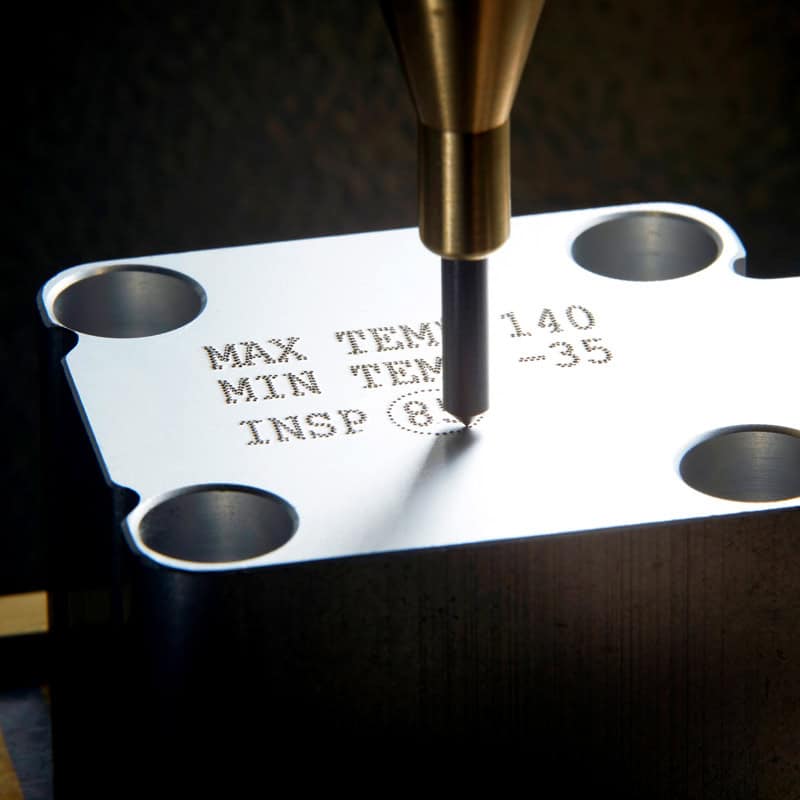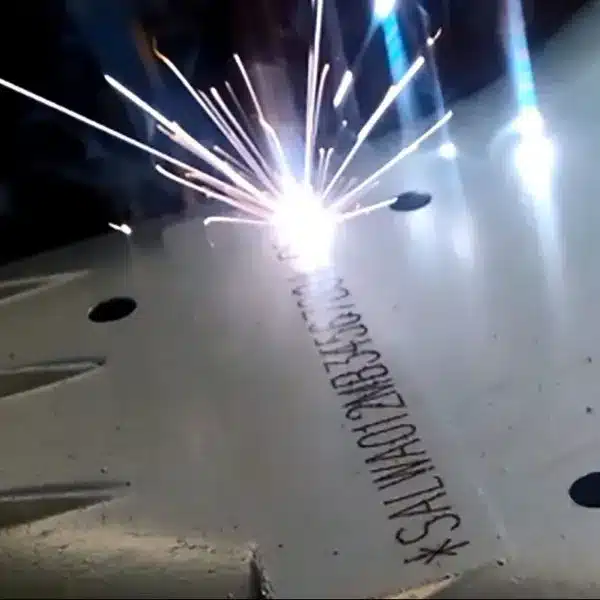Choosing the right marking technology: Dot Peen vs. Laser Marking
In the domain of direct part marking, Dot Peen and Laser Marking stand out as leading technologies, each presenting unique advantages for diverse industrial applications. Navigating the choice between these options requires a comprehensive understanding of their strengths and specific use cases. Whether you prioritise the lasting impact of Dot Peen’s precise, indented marks or the contactless, high-precision capabilities of Laser Marking, the decision hinges on your specific marking requirements.
We take a look into the comparative strengths of Dot Peen and Laser Marking, providing a valuable insight to help you make an informed choice of which is the best option for you.
 Dot Peen Marking Overview: Precision with Impact
Dot Peen Marking Overview: Precision with Impact
Overview: Dot Peen Marking, also known as pin marking or stylus marking, is a process where a pneumatically or electromagnetically driven stylus rapidly strikes the material’s surface, creating a series of dots. These dots collectively form alphanumeric characters, symbols, or codes.
Advantages:
- Low Stress: Dot peen marking is known to be the process that introduces the lowest stresses into a component
- Durability: Dot peen marks are deeply etched, ensuring durability and resistance to wear and environmental factors.
- Versatility: Suitable for various materials, including metals, plastics, and composites.
- Cost-Effective: Dot peen systems are generally more affordable than laser marking systems.
- Speed: Offers high-speed marking, contributing to efficient production processes.
Common Dot Peen Marking Applications:
- Aerospace
- Part numbering
- Label marking
- Date coding
- Serialisation
- Traceability in manufacturing
 Laser Marking: Precision without Contact
Laser Marking: Precision without Contact
Overview: Laser Marking uses a laser beam to mark or engrave the surface of a material. It’s a non-contact method, utilising lasers to remove or alter the material to create marks.
Advantages:
- Non-contact Process: No physical contact with the material, minimising the risk of damage.
- High Precision: Allows for intricate designs, including 2D codes, logos, and fine details.
- Clean and Permanent: Laser marks are clean, high-contrast, and permanent.
- Wide Material Compatibility: Suitable for various materials, including metals, plastics, ceramics, and more.
Common Laser Marking Applications:
- Automotive VIN marking
- Medical device marking
- Part numbering
- Logo and image marking
- Fine arts and jewellery
Choosing the Right Technology
Considerations:
- Material Compatibility: Both methods are versatile, but the nature of the material can influence the choice.
- Marking Specifications: Some industries have strict specifications restricting what method can be used
- Precision Requirements: Laser marking excels in intricate designs and fine details.
- Marking Speed: Laser marking can offer much quicker cycle time
Integrating Dot peen markers or Laser markers in an automated production line
Both Dot Peen markers and Laser markers can be integrated into an automated high-speed production line for marking and identification purposes. The choice between the two technologies depends on various factors including the material being marked, the required marking depth, speed of marking, and the desired permanence of the mark.
Laser markers generally offer higher marking speeds compared to Dot Peen markers. However, the choice between the two technologies will depend on various factors including the specific requirements of the production process, the type of material being marked, and the desired quality of the marks.
Pryor have many years’ experience and many examples of successful projects with the largest names in the Automotive and Aerospace industries where they have integrated both types of markers into automated production lines while working to a very high degree of accuracy.
Dot Peen and Laser marking vs just sticking on a label
In today’s manufacturing landscape, tracking parts and ensuring compliance with industry standards is crucial, in many cases it’s a legal requirement. Pryor specialises in direct part marking technologies such as laser marking and dot peen marking. These methods both offer permanent, readable marks that outlast alternatives like printing and labels. With advantages including durability, speed, flexibility, and minimal maintenance, investing in direct part marking ensures a higher ROI and reduces waste.
- Permanence: Laser and Dot Peen marking offer permanent marks that endure harsh environments and years of regular use. This helps to ensure the durability of your marking.
- Speed: These machines mark quickly, enabling more parts to be marked in less time with less waste.
- Sustainability: Constantly needing new ink and labels adds extra cost to both the bottom line and to the environment.
- Flexibility: Mark virtually any material, from metals to plastics to wood, with a range of machine configurations.
- Quality: Both technologies can be tied down with checks and instructions on Pryor’s control systems to ensure the correct data is marked first time, every time.
- Minimal maintenance: Avoid downtime associated with unclogging printers or fetching more labels, or refilling your ink.
- Higher ROI: With fewer consumables and greater efficiency, most companies find that permanent marking pays for itself.
Conclusion
In the Dot Peen vs. Laser Marking debate, the right choice depends on the specific needs of your application. If durability, speed, and cost-effectiveness are paramount, Dot Peen is an excellent choice. On the other hand, if you require high precision, intricate designs, and the ability to mark a wide range of materials without contact, Laser Marking might be the better fit.
Understanding your unique requirements and the strengths of each technology will guide you toward the best solution for your direct part marking needs. Whether you opt for the impact of Dot Peen or the precision of Laser Marking, both technologies contribute significantly to enhancing traceability, quality control, and overall efficiency in the manufacturing processes.
If you’re still not sure please get in touch with our team and see how we can help. Pryor have been at the cutting edge of marking and traceability technology for 175 years from Manual hand stamps and pioneering Dot Peen Marking to the latest in laser marking technology.
 Dot Peen Marking Overview: Precision with Impact
Dot Peen Marking Overview: Precision with Impact Laser Marking: Precision without Contact
Laser Marking: Precision without Contact